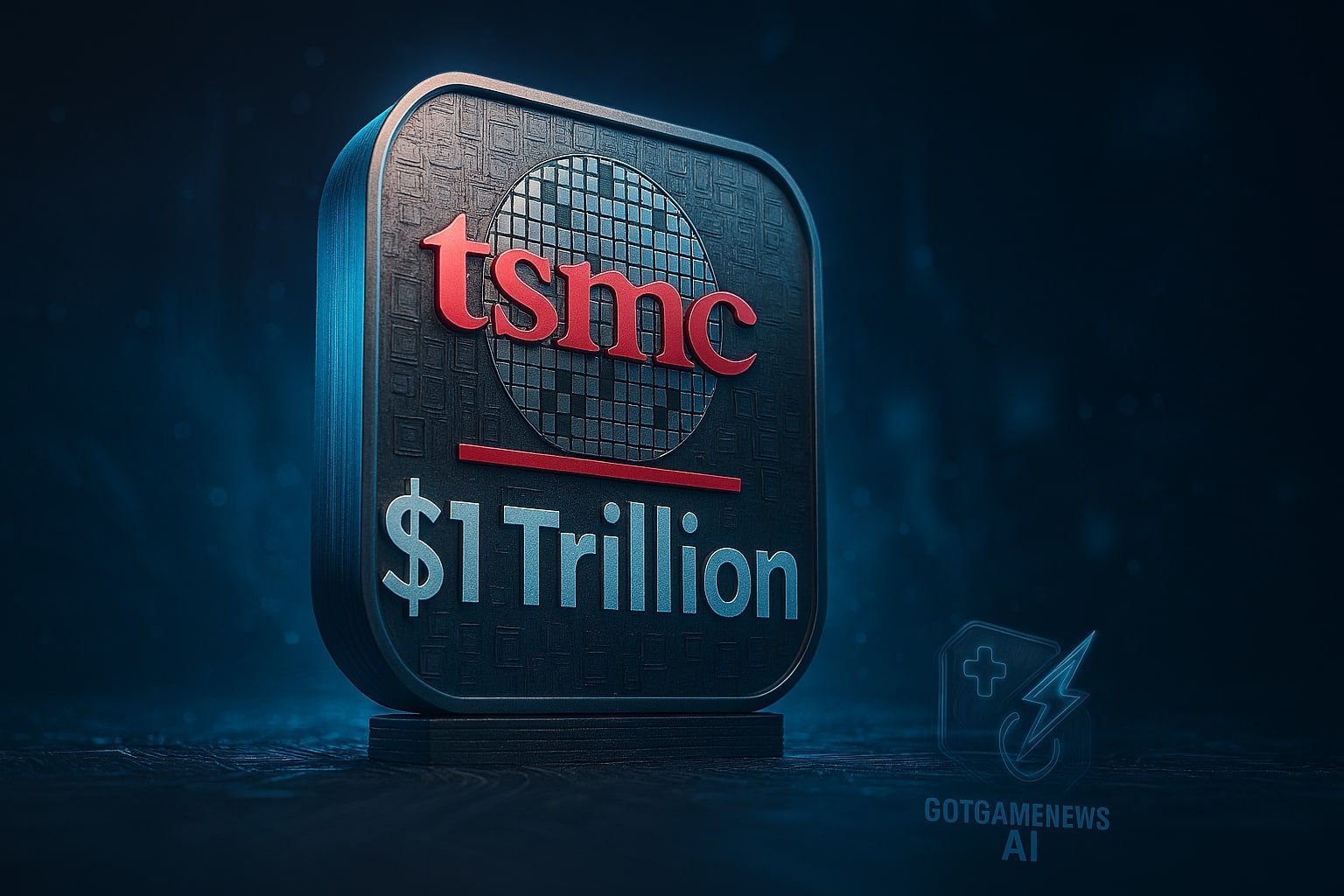1. The Milestone — What Just Happened
Last week, Taiwan Semiconductor Manufacturing Company (TSMC) crossed the $1 trillion market capitalization threshold—an unprecedented feat for an Asian stock since PetroChina briefly achieved it in 2007.
Key stats from Q2 2025 include:
- Revenue surged ~38–39% year-over-year to NT$933 billion (~US $31 billion).
- Net income soared ~60–61% to NT$398 billion (~US $13.5 billion).
- Full-year revenue guidance was raised to ~30% growth.
In local terms, TSMC’s shares jumped roughly 50% from April lows—a surge mirrored in its U.S.-listed ADRs at around $1.2 trillion valuation.
Why this matters:
This milestone cements TSMC’s role as a global bellwether. As the world’s preeminent pure-play foundry, it underpins the hardware backbone of AI—from Nvidia GPUs to Apple chips to datacenter accelerators. Its valuation leap is less “market bubble” and more “market validation.”
- 2. The AI Napalm: Fueling Demand and Pricing Power
- 3. Prudence Amid Global Expansion: Steady, Tactical Growth
- 4. Deeper Friction Zones: Geopolitics, Labor, & Security
- 5. Competitive Landscape: Rival Foundries and Market Implications
- 6. Macro & Market Risks: Potholes on a High-Speed Freeway
- 7. So What Now? The Path Forward
- 8. Meaning for the Tech Ecosystem & Global Markets
- 9. Outlook Summary: 2025–2028
- 10. Final Take
2. The AI Napalm: Fueling Demand and Pricing Power
TSMC’s earnings reflect one reality: AI isn’t just hype—it’s the ultimate margin engine in semiconductors.
A. No Signs of Cooling
Investor confidence stems from advanced node demand with AI customers showing no signs of a slowdown. Analysts also foresee a higher magnitude of price hikes in 2026 for premium chips.
AI spending and wafer pricing strength are expected to buffer margins even amid currency headwinds. TSMC’s Q2 showed High-Performance Computing (HPC) chips alone making up ~60% of sales—a sign that datacenter demand is a structural growth driver.
B. Node Leadership—and Locked-In Clients
TSMC leads at 3 nm, rolling out 2 nm in R&D pipelines—used in top-end AI chips. Customers like Nvidia, Apple, AMD, Google, and Microsoft depend on this edge. Every process leap yields new performance, efficiency, and pricing leadership—making customers stickier.
3. Prudence Amid Global Expansion: Steady, Tactical Growth
Despite the momentum, TSMC’s rhetoric is cautious. Financial leadership is explicit: the company must balance global buildup with disciplined capital management.
A. Managing Capex & Macro Risks
TSMC’s CFO described a “big uncertainty” from foreign exchange volatility, especially Taiwan dollar strength, which hurt margins by ~3pp without hedging. The U.S. expansion, primarily financed by CHIPS Act subsidies and internal funds, is subject to macro swings and tariff sensitivity.
Though adding ~US $165 billion in U.S. investment—including $100 billion already announced—the company remains mindful about macro uncertainties and is being prudent about planning its capex.
B. Strategic U.S. Footprint: At Risk and Reward
TSMC is fast-tracking chip production in Phoenix, Arizona, with its second fab accelerated by multiple quarters. Upon full buildout, ~30% of its most advanced chips (≤5 nm) will originate in the U.S.—a direct response to CHIPS Act objectives.
However, the U.S. buildout is far from frictionless. Construction costs are 4–5x Taiwan’s, and skilled labor scarcity forced Taiwanese engineers to train U.S. staff—contributing to project delays into 2025–2028. Political and operational risk are baked into every square foot.
4. Deeper Friction Zones: Geopolitics, Labor, & Security
TSMC sits at the center of a geopolitical maelstrom that reshapes global power dynamics.
A. U.S.–China Trade & Tech Contest
TSMC is targeted by U.S. tariffs and export-control regimes but remains partially shielded through participation in subsidies and domestic manufacturing exceptions.
Taiwan’s government has pledged to keep its most advanced tech “Taiwan-only,” ensuring that U.S. fabs won’t get access to bleeding-edge nodes. However, some argue this may gradually weaken Taiwan’s so-called “silicon shield”—the strategic leverage its chip dominance provides.
B. Workforce Frictions & Union Tensions
Ramping up Arizona fabs revealed labor gaps. Taiwanese-trained engineers are required, creating friction with U.S. unions over wages and training reciprocity. The CHIPS Act includes incentives for labor agreements, but TSMC’s pace might outstrip local consensus.
C. Security: Espionage & IP Integrity
Taiwan’s semiconductor ecosystem has been a target of cyber-espionage. Addressing these threats adds an invisible layer of operational cost and security diligence.
5. Competitive Landscape: Rival Foundries and Market Implications
TSMC doesn’t just compete on nodes; its posture reshapes the competitive chessboard.
- Samsung Foundry is racing at 3 nm and 2 nm but remains behind in yield, scale, and customer diversity.
- Intel Foundry Services is trying to catch up, supported by U.S. political will, but lacks TSMC’s mature process library and customer ecosystem.
- China-based fabs face U.S. export limits and haven’t breached 5 nm at scale.
TSMC’s node leadership, pricing power, and global footprint form a near-insurmountable moat for the next several years.
6. Macro & Market Risks: Potholes on a High-Speed Freeway
Even with stellar momentum, TSMC faces headwinds:
A. Currency & Tariff Fluctuations
A stronger New Taiwan dollar cuts revenue and margins when translating overseas, while renewed protectionist tariffs could disrupt supply chains or infrastructure rollout.
B. Capital-Expenditure Discipline
U.S. expansion means committing hundreds of billions, and any misstep in cost control or scheduling would directly dent margins.
C. Demand Plateau
While AI demand is still increasing, broader economic slowdowns or cyclical downgrades in enterprise or consumer tech could dilute momentum. TSMC has already flagged a slight Q3 margin decline (to ~45–47%) due to forex and overseas operations.
7. So What Now? The Path Forward
TSMC’s short-term roadmap hinges on delivering on two fronts:
- Operational Execution:
- Q3 guidance: US $31.8–33 billion in revenue (~38% YOY growth).
- Arizona fabs: Phase 2 must launch soon to hit the 30% advanced volume goal.
- Margin Management:
- Monitor forex hedging effectiveness.
- Improve efficiency despite U.S. cost premiums.
- Strategic Signaling:
- Taiwan must maintain leadership and reassure stakeholders that bleeding-edge production stays domestic.
- U.S. subsidies will affect capital efficiency going forward.
8. Meaning for the Tech Ecosystem & Global Markets
TSMC is no longer just a foundry—it’s a linchpin in the global tech architecture. Its $1 trillion valuation represents more than scale: it signals who controls the physical layer of AI.
- For AI firms: Volume and node parity will increasingly define competitive advantage. Nvidia, AMD, and Google are essentially reliant on TSMC’s capacity.
- For investors: TSMC’s premium valuation signals confidence in the chip supply chain’s centrality to AI economics.
- For geopolitics: Taiwan’s chip dominance grants strategic leverage—but preserving this edge requires careful diplomacy and tech safeguarding.
- For labor and policy: The semiconductor boom highlights gaps in skilled labor pipelines and may reshape national industrial strategies.
9. Outlook Summary: 2025–2028
| Timeframe | Key Developments | Watch-items |
|---|---|---|
| Q3 2025 | Revenue ~US $32B; Margin ~45–47% | Forex hedging, pricing pass-through |
| 2026 | 2 nm R&D yields; Possible price hike | Node leadership sustains AI lead |
| 2027–28 | Arizona fabs ramp; 30% volume in U.S. | Timeline adherence |
| Beyond | U.S. production dependencies; future fabs in Europe, Japan | Global supply chain diversification |
—
10. Final Take
TSMC’s leap into the trillion-dollar club is both symbolic and structural. AI demand has unlocked a pricing paradigm shift behind the scenes—allowing the chipmaker to raise guidance, expand aggressively, and justify massive valuations.
Yet leadership isn’t just about speed—it’s about stewardship. As TSMC rides AI’s wave, capital discipline, geopolitical navigation, labor strategy, and IP security will define whether the company merely joins the club’s elite… or shapes its next frontier.





